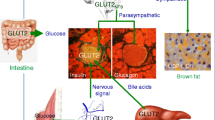Abstract
The Kv2.1/Kv9.3 heteromer generates an O2 sensitive potassium channel and induces a slow deactivation that has important consequences for brain and lung physiology. We examined the developmental regulation of Kv2.1 and Kv9.3 mRNAs in brain and lung. Both genes followed parallel expression patterns in brain, increasing progressively through post-natal life. In lung, however, the expression of the two genes followed opposite trends: Kv2.1 transcripts decreased, while Kv9.3 mRNA increased. The Kv9.3/Kv2.1 ratio shows that while in brain the expression of both genes followed a similar pattern, the relative abundance of Kv9.3 increased steadily through post-natal life in lung. Furthermore, there is selective regulation of gene expression during the suckling-weaning transition. Our results suggest that different Kv9.3/Kv2.1 ratios could have physiological implications in both organs during postnatal development, and that diet composition and selective tissue-specific insulin regulation modulate the expression of Kv2.1 and Kv9.3.
Resumen
El heterómero Kv2.1/Kv9.3 genera un canal de potasio sensible al O2 e induce una inactivación lenta que tiene consecuencias importantes en la fisiologiá cerebral y pulmonar. Se examina la regulación durante el desarrollo de los mRNA de Kv2.1 y Kv9.3 en cerebro y pulmón. Los dos genes presentan una expresión paralela en cerebro, incrementando progresivamente durante la vida post-natal. Sin embargo, la expresión de los dos genes sigue patrones opuestos en pulmón. Así, mientras que dismuye la expresión de Kv2.1, se incrementa la de Kv9.3. La relación Kv9.3/Kv2.1 demuestra que mientras en cerebro la expresión de los dos genes sigue un patrón similar, la abundancia relativa de Kv9.3 aumenta durante la etapa post-natal en pulmón. Estos resultados indican que una relación diferente entre Kv9.3/Kv2.1 puede tener implicaciones fisiológicas en ambos órganos durante el desarrollo post-natal. Además, existe una regulación selectiva de la expresión génica durante la transición del destete. Nuestros datos sugieren que tanto la composición de la dieta como una regulación selectiva específica de cada tejido condicionan la expresión de Kv2.1 y Kv9.3.
Similar content being viewed by others
References
Batchelor, D. C., Lewis, R. M., Breier, B. H., Gluckman, P. D. and Skinner, S. J. M. (1998):J. Mol. Endocrinol.,21, 73–84.
Carrasco, M., Portillo, F., Larsen, P. J. and Vallo, J. J. (2001):J. Neuroendocrinol.,13, 339–346.
Castelló, A., Rodríguez-Manzaneque, J. C., Camps, M., Pérez-Castillo, A., Testar, X., Palacín, M., Santos, A. and Zorzano, A. (1994):J. Biol. Chem.,269, 5905–5912.
Coppock, E. A., Martens, J. R. and Tamkun, M. M. (2001):Am. J. Physiol. Lung. Cell. Mol. Physiol.,281, 1–12.
Cornfield, D. N., Saqueton, C. B., Porter, V. A., Herron, J., Resnik, E., Haddad, I. Y. and Reeve, H. L. (2000):Am. J. Physiol. Lung. Cell. Mol. Physiol.,278, 1297–1304.
Felipe, A., Knittle, T. J., Doyle, K. L., Snyders, D. J. and Tamkun, M. M. (1994):Am. J. Physiol. Cell. Physiol.,267, 700–705.
Ferre, P., Decaux, J. F., Issad, T. and Girard, J. (1986):Reprod. Nutr. Dev.,26, 619–631.
French, G. C., VanDongen, A. M. J., Schuster, G., Brown, A. M. and Joho, R. H. (1989):Nature,340, 642–645.
Gauda, E. B. and Lawson, E. E. (2000):Respir. Physiol.,121, 199–208.
Hille, B. (2001): Ion Channels of Excitable Membranes. Sinauer Associates, Sunderland, MA.
Hulme, J. T., Coppock, E. A., Felipe, A., Martens, J. R. and Tamkun, M. M. (1999):Circ. Res.,85, 489–497.
Issad, T., Coupe, C., Pastor-Anglada, M., Ferre, P. and Girard, J. (1988):Biochem. J.,251, 685–690.
Kerschensteiner, D. and Stocker, M. (1999):Biophys. J.,77, 248–257.
Kilgour, E. and Vernon, R. G. (1987):Biochem. J.,243, 69–74.
Kramer, J. W., Post, M. A., Brown, A. M. and Kirsch, G. E. (1998):Am. J. Physiol. Cell. Physiol.,274, 1501–1510.
Lesage, F., Attali, B., Lazdunski, M. and Barhanin, J. (1992):FEBS Lett.,310, 162–166.
McDaniel, S. S., Platoshyn, O., Yu, Y., Sweeney, M., Miriel, V. A., Golovina, V. A., Krick, S., Lapp, B. R., Wang, J. Y. and Yuan J. X. (2001):J. Appl. Physiol.,91, 2322–2333.
Michelakis, E. D., McMurtry, M. S., Wu, X. C., Dyck, J. R. B., Moudgil, R., Hopkins, T. A., Lopaschuk, G. D., Puttagunta, L., Waite, R. and Archer, S. L. (2002):Circulation,105, 244–250.
Pappano, A. J. (1977):Pharmacol. Rev.,29, 3–33.
Patel, A. J., Lazdunski, M. and Honoré, E. (1997):EMBO J.,16, 6615–6625.
Platoshyn, O., Yu, Y., Golovina, V. A., McDaniel, S. S., Krick, S., Li, L., Wang, J. Y., Rubin, L. J. and Yuan, J. X. J. (2001):Am. J. Physiol. Lung. Cell. Mol. Physiol., 280, 801–812.
Pracyk, J. B. and Slotkin, T. A. (1992):J. Pharmacol. Exp. Ther.,261, 951–958.
Qin, D., Huang, B., Deng, L., El-Adawi, H., Ganguly, K., Sowers, J. R. and El-Sherif, N. (2001):Biochem. Biophys. Res. Commun.,283, 549–553.
Roberts, S. L. and Tamkun, M. M. (1991):FEBS Lett.,284, 152–154.
Salinas, M., de Weille, J., Guillemare, E., Lazdunski, M. and Hugnot, J. P. (1997):J. Biol. Chem.,272, 8774–8780.
Santalucía, T., Camps, M., Castelló, A., Muñoz, P., Nuel, A., Testar, X., Palacín, M. and Zorzano, A. (1992):Endocrinology,130, 837–846.
Soler, C., García-Manteiga, J., Valdés, R., Xaus, J., Comalada, M., Casado, F. J., Pastor-Anglada, M., Celada, A. and Felipe, A. (2001):FASEB J.,15, 1979–1988.
Spanswick, D., Smith, M. A., Mirshamsi, S., Routh, V. H. and Ashford, M. L. (2000):Nat. Neurosci.,3, 757–758.
Stocker, M., Hellwing, M. and Kerschensteiner, D. (1999):J. Neurochem.,72, 1725–1734.
Trimmer, J. S. (1993):FEBS Lett.,324, 205–210.
Zhao, W. and Alkon, D. L. (2001):Mol. Cell. Endocrinol.,177, 125–134.
Author information
Authors and Affiliations
Rights and permissions
About this article
Cite this article
Coma, M., Vicente, R., Tsevi, I. et al. Different Kv2.1/Kv9.3 heteromer expression during brain and lung post-natal development in the rat. J. Physiol. Biochem. 58, 195–203 (2002). https://doi.org/10.1007/BF03179857
Received:
Issue Date:
DOI: https://doi.org/10.1007/BF03179857




